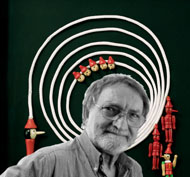 |
Around Pinocchio
Aldo Capasso
A collector becomes the director of graphic, photographic
and object assemblages of Pinocchio gadgets and images.
Work description
It is quite difficult for me to tell “my” Pinocchio: in the
world of fantasy finding logics or rational explanations is
complicated. Fantasy deals with feelings, emotions and the
sense of play that makes you observe first and then build
images and signs.
The rational part of me induced me to think about
Pinocchio’s tale and its effects on culture, society and
mass media.
My works were born from my thoughts about Collodi’s world.
First of all the unique event of a father, Geppetto, who
“generates” a son, Pinocchio and the intense, strong
relationship between them. Second, the marginal presence of
a woman, the fairy, which is odd in a fairy tale and last,
the search of a world free from duties but full of
misadventures and remorse, as it happens to ingenuous kids,
where lies are irrelevant. Fictional characters complete the
amazing picture with the humanization of nature and animals,
far beyond the work’s moral aim.
My attention focused on the implications this fairy tale has
had on literature and children’s literature through the
numerous brief or full writings published in every language,
on arts with great illustrators and artists creating
illustrations for the story, as well as on the cinema,
television and the theatre.
Finally, the most surprising aspect is the production of
gadgets, puppets, games and a variety of objects of
different materials and shapes that is evidence of the
success and love for a fictional character that has become
the icon of lies and that is often cited in politics and
morals.
This is what inspired me – Pinocchio involved kitsch and
object producers in impossible, improbable and unthinkable
interpretations between serious and grotesque, as well as
scholars artists and craftsmen.
In 1985 I designed a public garden dedicated to Pinocchio on
Ischia (Piedimonte di Barano). It was intended to offer an
area to the fantasy of the children of a nearby school and
to the small community of Piedimonte.
This was the beginning of my adventure in Collodi’s world
that involved the sculptor Antonio Borrelli in the creation
of a Pinocchio bronze sculpture for the garden,
unfortunately replaced by a second-rate fibreglass statue of
Padre Pio. Later on I started to collect books and gadgets
dedicated to Pinocchio and in the following years I gathered
such an amount of objects that caused me concern about their
preservation and visibility.
The American artist Joseph Cornell’s (1903/1972) exhibition
in Florence (1903/1972) impressed me with his
three-dimensional compositions and the assemblage of
drawings and objects in showcases. I thought, then, that the
assemblage of writings, drawings and objects about Pinocchio
could be a way to give dignity to this multifaceted
production dedicated to Pinocchio.
This would have made me part of the so called “Assemblage
art”, very popular in the ’50, that associates signs with
objects and was celebrated in the exhibition “The art of
Assemblage” at the New York Museum of Modern Art in 1961
where works by Braque, Dubuffet, Natcel Duchamp, Picasso,
Robert Rauschenberg, Man Ray e Kurt Schwitter and J. Cornell
were displayed.
Far from comparing myself with any of these artists, I tried
to put the tale of Pinocchio in showcases. I played with
objects and drawings of the puppet and tried to give my
personal contribution to celebrate this fictional character
by “organizing” handmade, sometimes kitsch objects that
fascinate grownups and kids alike.
I wish to conclude by quoting my dear friend and artist
Giuseppe Antonello Leone “Aldo Capasso, the collector of
gadgets and books becomes director –surreal. He assembles
with sacred austerity hundreds of showcases telling the
story of father and son in rigorously square formal spaces.”
The works displayed here are part of the production
collected in my studio-house in Naples, that my friend Leone
affectionately defined Pinocchiothèque.
|